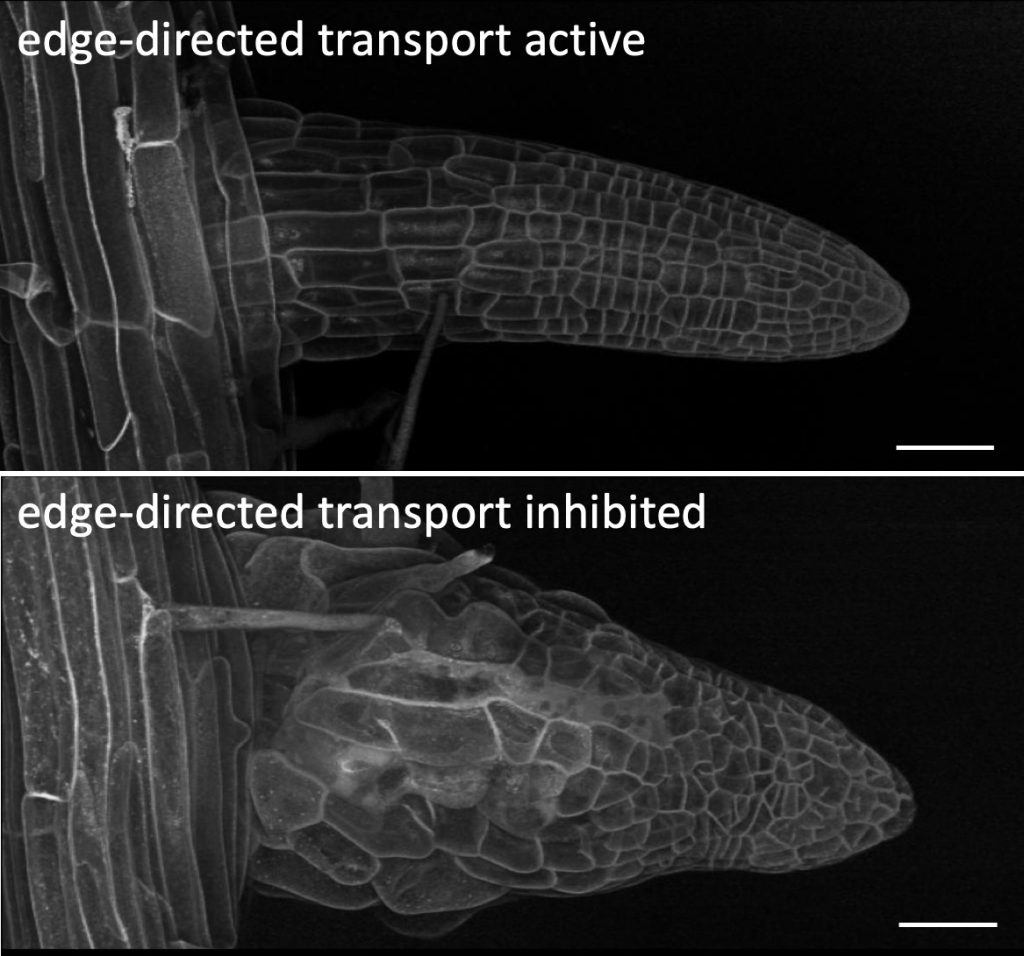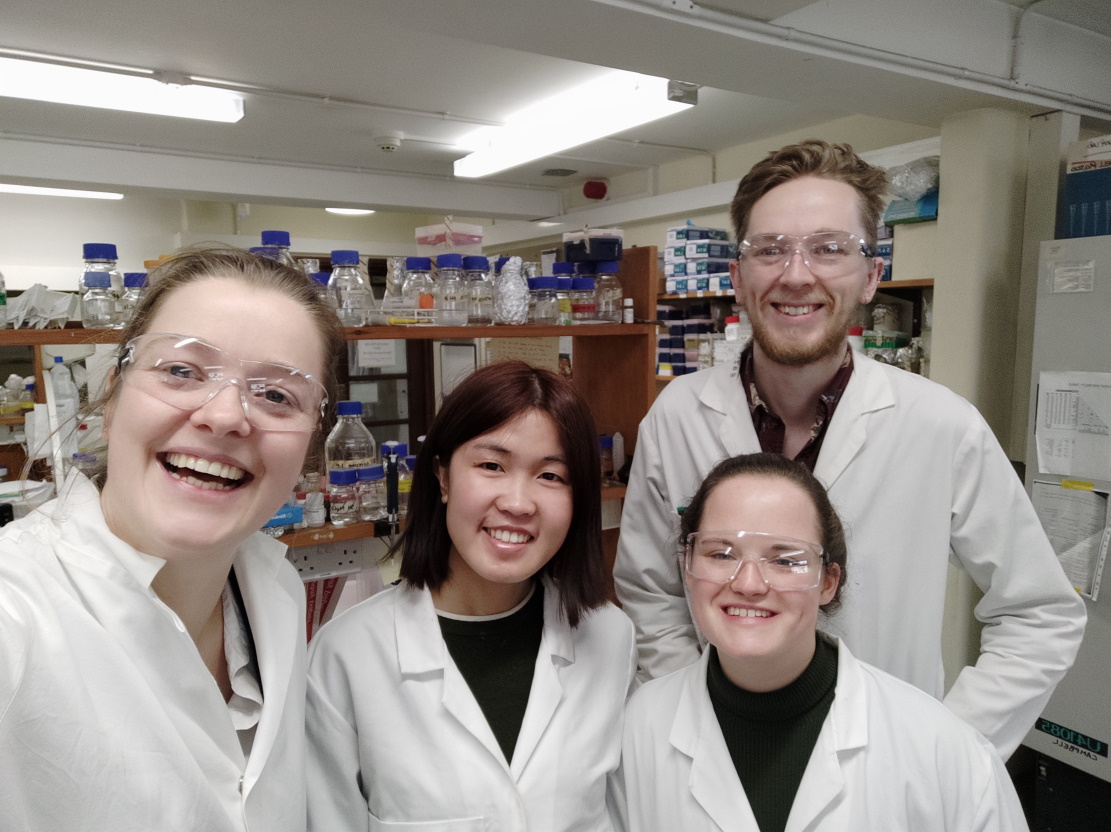Short and bushy, long and spindly: how plants make their shapes
Dr Charlotte Kirchhelle, based at the University of Oxford, is investigating the role of cell geometry in shaping plants’ organs – namely, the roots, leaves, stem and reproductive organs. Understanding the fundamental cellular mechanisms driving organ shape could lead to new ways of manipulating and improving crops around the world
TALK LIKE A MOLECULAR PLANT BIOLOGIST
Molecular biology – a field of biology that studies the composition, structure and interactions of cellular molecules
Computational modelling – the use of computers to simulate and study the behaviour of complex systems using mathematics, physics and computer science
Plant morphogenesis – the study of the origin and development of the physical form and external structure of plants
RAB-A5c – a protein that controls the directional growth of plants
According to a recent report from the Royal Botanic Gardens, Kew in the UK, of the estimated 8.7 million species on Earth, more than 391,000 are plants. The breadth of diversity in these plants is extraordinary – from the smells they produce, through to the amazing array of colours on display – they remind us of how beautiful Earth can be. There are also huge differences in the shape of plants organs – leaves, flowers and roots – and the process by which these organs are made is called plant morphogenesis.
Dr Charlotte Kirchhelle, who is based in the Department of Plant Sciences at Oxford University, UK, has dedicated her life to studying plant morphogenesis. “While animals generally form their organs early in their life, plants continuously make organs throughout their life,” explains Charlotte. “Plants face a special challenge when making new organs: all cells, which are the individual units that make up an organ, are connected to each other through the cell wall, which surrounds each cell and is shared by adjacent cells. Adjacent cells therefore need to coordinate precisely how fast and in which direction they grow.”
WHAT ARE CELL GEOMETRIC EDGES?
The role of cell geometric edges was only recently discovered, and Charlotte’s current research is focused on discovering more about them. Put simply, cell geometric edges are the regions of a cell where two faces meet (see the image below called: What is a cell edge?). They must constantly adapt to whatever the adjacent cell walls are doing to ensure they retain their structure and stability. “When plant cells were identified originally, their striking shapes inspired mathematical descriptions of cells as ‘polyhedra’ with edges and faces,” says Charlotte. “Later, molecular plant biologists found that these different geometric domains can also have biochemically different identities, for example through specific proteins that only occur at some cell faces.”

However, over the past decade, researchers have found that different proteins can also accumulate at cell edges. Charlotte’s team recently identified one of these edge-localised proteins (this protein is shown in green in the image below: What is a cell edge?). They found that it is required to ensure that cells grow in the right direction. (To see what happens when this protein called RAB-A5c is disrupted, see the image below: What happens when edge-localised proteins stop working properly?).

WHAT HAPPENS WHEN EDGE-LOCALISED PROTEINS STOP WORKING PROPERLY?
Reference
https://doi.org/10.33424/FUTURUM47
Molecular biology – a field of biology that studies the composition, structure and interactions of cellular molecules
Computational modelling – the use of computers to simulate and study the behaviour of complex systems using mathematics, physics and computer science
Plant morphogenesis – the study of the origin and development of the physical form and external structure of plants
RAB-A5c – a protein that controls the directional growth of plants
According to a recent report from the Royal Botanic Gardens, Kew in the UK, of the estimated 8.7 million species on Earth, more than 391,000 are plants. The breadth of diversity in these plants is extraordinary – from the smells they produce, through to the amazing array of colours on display – they remind us of how beautiful Earth can be. There are also huge differences in the shape of plants organs – leaves, flowers and roots – and the process by which these organs are made is called plant morphogenesis.
Dr Charlotte Kirchhelle, who is based in the Department of Plant Sciences at Oxford University, UK, has dedicated her life to studying plant morphogenesis. “While animals generally form their organs early in their life, plants continuously make organs throughout their life,” explains Charlotte. “Plants face a special challenge when making new organs: all cells, which are the individual units that make up an organ, are connected to each other through the cell wall, which surrounds each cell and is shared by adjacent cells. Adjacent cells therefore need to coordinate precisely how fast and in which direction they grow.”
WHAT ARE CELL GEOMETRIC EDGES?
The role of cell geometric edges was only recently discovered, and Charlotte’s current research is focused on discovering more about them. Put simply, cell geometric edges are the regions of a cell where two faces meet (see the image below called: What is a cell edge?). They must constantly adapt to whatever the adjacent cell walls are doing to ensure they retain their structure and stability. “When plant cells were identified originally, their striking shapes inspired mathematical descriptions of cells as ‘polyhedra’ with edges and faces,” says Charlotte. “Later, molecular plant biologists found that these different geometric domains can also have biochemically different identities, for example through specific proteins that only occur at some cell faces.”

However, over the past decade, researchers have found that different proteins can also accumulate at cell edges. Charlotte’s team recently identified one of these edge-localised proteins (this protein is shown in green in the image below: What is a cell edge?). They found that it is required to ensure that cells grow in the right direction. (To see what happens when this protein called RAB-A5c is disrupted, see the image below: What happens when edge-localised proteins stop working properly?).

WHAT HAPPENS WHEN EDGE-LOCALISED PROTEINS STOP WORKING PROPERLY?
The next stage is to discover exactly how this mechanism works, why plants use other mechanisms to control growth directions, and how these different mechanisms relate to each other.
WHAT TECHNIQUES IS CHARLOTTE USING IN HER RESEARCH?
The processes involved in plant morphogenesis are extremely complex. This means that adopting traditional experimental approaches is insufficient. With that in mind, Charlotte has taken an interdisciplinary approach, which combines classic molecular biology with quantitative imaging and computational modelling. These techniques enable the team to study the individual molecules involved in morphogenesis and see how they affect cellular growth.
“Our studies use specialised microscopy techniques, which allows us to image cells and their contents with very high resolution,” explains Charlotte. “To visualise different parts of the cell, we use fluorescent proteins (see image on page 1: What is a cell edge?) and, based on our experiments, we develop hypotheses for the functions of our proteins, which we can test in computational models. Depending on the outcome of the model, we can then come up with new experiments.”
WHY IS THIS RESEARCH IMPORTANT?
Understanding how plants make their organs is a fundamental question in biology. Of course, enhancing our understanding of how living organisms function is important full stop, but there is an implication that could become increasingly important in the future. “Answering these questions is important in an agricultural context, because we all depend on plants for our food and fuel,” says Charlotte. “Understanding how organs are shaped will help us manipulate and improve them in crop species.”
WHAT HAVE THE TEAM DISCOVERED UP TO THIS POINT?
They have identified a protein called RABA5c that localises cell edges in young roots. This protein has been found to be required for controlling directional growth in plants and that it acts independently of other known mechanisms involved in controlling plant directional growth.
 DR CHARLOTTE KIRCHHELLE
DR CHARLOTTE KIRCHHELLE
Department of Plant Sciences
Oxford University, UK
FIELD OF RESEARCH: Plant Sciences and
Molecular Biology
RESEARCH PROJECT: Charlotte is investigating plant morphogenesis – the study of the origin
and development of the physical form and
external structure of plants.
FUNDERS: The Leverhulme Trust, Biotechnology and Biological Sciences Research Council
 DR CHARLOTTE KIRCHHELLE
DR CHARLOTTE KIRCHHELLE
Department of Plant Sciences
Oxford University, UK
FIELD OF RESEARCH: Plant Sciences and
Molecular Biology
RESEARCH PROJECT: Charlotte is investigating plant morphogenesis – the study of the origin
and development of the physical form and
external structure of plants.
FUNDERS: The Leverhulme Trust, Biotechnology and Biological Sciences Research Council
Molecular plant biology is the study of the molecular basis of plant life. It is about understanding the processes by which information within the organism translates into structures, processes and behaviours. Interestingly, there are some similarities in the mechanisms that exist in plants, animals and fungi. For example, the cells of all multicellular organisms contain different compartments surrounded by membranes with different functions. These include a nucleus (which contains most of the cell’s DNA), the endoplasmic reticulum (in which many proteins are made), and small vesicles (which transport different molecules from one part of the cell to another).
But it is perhaps the differences in plant mechanisms that are the most exciting aspects to study. In contrast to animal cells, plant cells are surrounded by a rigid cell wall. To construct this wall, they need to produce and transport special molecules to the cell surface. These molecules do not exist in animal cells. It also means plant cells cannot simply divide by constriction (narrowing and closing) like animal a cell plate between two daughter cells (cells that result from the division of a single parent cell). The molecular machinery behind these mechanisms is unique to plants.
ARE THERE MANY CAREER OPPORTUNITIES IN MOLECULAR PLANT BIOLOGY?
Molecular plant biology is a field that can take you into industry as much as it can academia. Opportunities typically include those in the farming industry, laboratories or medical facilities. Charlotte says that the need to breed and improve crops in the future ensures there will be always be a demand for molecular plant biologists. “Many big agricultural companies like Syngenta have large research and development departments,” explains Charlotte. “Many of the basic techniques applied in molecular plant biology are similar to those used in other biotechnology sectors, and I know many plant scientists who have switched into the pharmaceutical industry.”
SHOULD YOU PURSUE A CAREER IN THE FIELD?
If you crave variety and an element of freedom, then studying molecular plant biology in laboratories might be the best course of action for you. “I do primary research like lab experiments, but also travel to conferences in different countries to present my research, write research papers and proposals for new research projects, and teach undergraduate and graduate students,” says Charlotte.
There is also a wide range of opportunities in industry, which may not see you travelling around the world, but will see you performing important work that could have positive impacts around the world.
WHAT DOES CHARLOTTE LOVE MOST ABOUT HER RESEARCH?
“There is a famous poem by the German poet Johann Wolfgang von Goethe from 1790 called The Metamorphosis of Plants, in which he ponders on ‘the secret law’ governing how plants shape their organs,” says Charlotte. “I find it very rewarding to work on a question that has enticed people for centuries, and yet we are still discovering new things about it!”
• The Royal Horticultural Society has lots of great resources to help you make up your mind as to whether a career with plants is for you: courses, workshops, citizen science projects, competitions and much, much more.
• If you are interested in becoming a plant biologist, you should take a look at environmentalscience.org – although it is aimed at an American audience, the details of what is involved in the role are the same around the world. Interestingly, demand for plant biologists is expected to grow at a faster rate than the average growth for all jobs
• According to the National Careers Service, the average salary for a plant biologist can range from anywhere between £22,000 and £55,000, depending on whether you’re just starting out or are more experienced.
HOW DID DR CHARLOTTE KIRCHHELLE BECOME A PLANT BIOLOGIST ?
WHAT DID YOU IMAGINE YOURSELF DOING WHEN YOU WERE YOUNGER?
For a long time, I did not have a clear idea of what I wanted to do – mainly because I was interested in many different things! I always liked science, but also languages and art. In Germany, the equivalent of A-levels does not involve the same level of specialisation as the UK, so my major subjects were maths, English, biology and politics, alongside many minor subjects. I always enjoyed studying at school, so I wanted to go to university, but I only decided at the last minute what subject to do.
YOU HAVE A BSC AND AN MSC IN BIOLOGY FROM TECHNICAL UNIVERSITY MUNICH IN GERMANY. WHO OR WHAT INSPIRED YOU TO GET INTO BIOLOGY?
I had a hard time deciding what to study, but I always enjoyed what my older sister told me about her degree in medicine – although my interest was in the parts relating to the human body, not the actual diseases! That led me to think that biology might be the perfect subject for me. My parents have a huge garden and, as children, we would spend a lot of time outside playing and helping out, but I never thought I would become a plant scientist. Fortunately, I loved the biology degree immediately and never looked back.
IF YOU COULD GO BACK IN TIME, WHAT ADVICE WOULD YOU GIVE YOURSELF WHEN YOU WERE YOUNGER?
To create opportunities for myself and explore interesting options. I come from a small village and it never occurred to me to go abroad until my master’s degree. One of my mentors once said to me: “The only way to make sure you do not get in is by not applying.” I think about that a lot – it is so easy to miss exciting opportunities if you don’t try to seek them out.
WHAT DO YOU LIKE TO DO IN YOUR SPARE TIME?
I have a young daughter, so I spend a lot of time with her and my husband. We like to travel and go to museums, especially natural history ones. I also enjoy cooking, which I find incredibly relaxing. In contrast to scientific experiments, which can take many days, there is an immediate result, which I am a big fan of.
FINALLY, WHY ARE YOU PASSIONATE ABOUT STEM EDUCATION AND OUTREACH?
When I started my degree, I had no idea about fundamental research, which is essentially driven by curiosity rather than a specific application. I think scientists sometimes have a tendency to isolate themselves and not speak about their work. All sorts of different research projects are important, but the amazing thing about curiosity-driving research is that it is not limited by applying what we already know, but aims to explore unchartered areas and push the limits of our knowledge. The technical details of how we achieve this can be difficult to understand, but the big questions are not – I think they can be exciting for everybody.
CHARLOTTE’S TOP TIPS
1 Involve yourself in the field of plant biology as soon as you can. One of the most wonderful experiences during my undergraduate degree was a visit to the plant genetics research departments at my university for a tour of the department and some research presentations from different researchers.
2 There are many different ways to get involved in plant biology, but after the visit I mentioned above, I did an internship and also worked as a student research assistant. This prepared me for something that happens rather a lot – failing in the lab! But that’s an essential part of any researcher’s life.
3 I encourage budding biologists to get in touch with lecturers or other scientists they find inspiring to explore opportunities to see their research first-hand. To see active research with its challenges and excitements is a wonderful experience.






